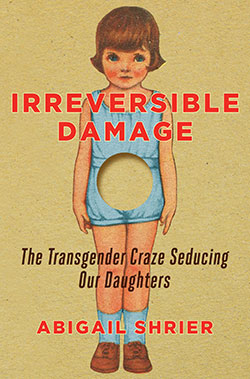Note from Randy: This fifth article in our series on gender confusion is an important and sobering book review written by Al Stewart (National Director of the Fellowship of Independent Evangelical Churches in Australia). He does a good job of summarizing the key points from Irreversible Damage: Teenage Girls and the Transgender Craze by Abigail Shrier. Although her book isn’t presented from a Christian worldview, it helps us understand the social contagion of transgenderism that is hurting many young people around the world.
These statistics and facts are hard to read. But unless we understand the magnitude of the issues our children and grandchildren face, we can’t respond with wisdom and counteract the lies with God’s truth. Paul says, “We demolish arguments and every pretension that sets itself up against the knowledge of God, and we take captive every thought to make it obedient to Christ” (2 Corinthians 10:5). As I’ve often said about abortion—and I believe is also true of transgenderism—we are not dealing here with “one more social issue,” but a unique and focused evil in which Satan has deeply vested interests. This is another example of how the evil one has a special hatred of children, and in this case, targets them with gender confusion. He wants to kill them, and he lies to facilitate and cover his attempts to destroy them.
Consider watching these stories, produced by Independent Women’s Forum, of women who have detransitioned. All of them are heartbreaking in their own way, and some are hard to watch as they do show the results of life-altering surgeries. Watch them at your own discretion, but I share them because it is better that someone should be repulsed by evil than indifferent to or drawn to it.
Here is Daisy Strongin’s story:
Only the light of God’s truth can set us free (John 8:32). May we speak the truth in love to a lost and increasingly confused, disoriented, and deceived generation. (Remember, to shine with His light, we must first allow Him daily to shine His light upon us.)
Review: Irreversible Damage by Abigail Shrier
By Al Stewart
A decade ago, the number of people in the USA identifying as transgender was approx. 1 in 10,000, now 2% of high school students, identify as transgender. (See page 32)
This is a troubling book about an epidemic damaging the lives of many, many teenage girls. While the book is particularly focused on the United States, this contagion, spread by the internet, is beginning to affect many westernized societies.
Abigail Shrier is a journalist who writes for the Wall Street Journal. She paints a grim picture:
- of depressed and anxious adolescent girls at vulnerable stages in their life;
- of influencers who use the internet to spread what is effectively a cult;
- of damaging responses to mental health problems;
- of weak and woke counsellors who are not the gatekeepers they should be;
- of educators who have allowed activists ongoing access to school children;
- of morally weak or incompetent, or simply greedy surgeons making money from this epidemic regardless of the human cost; and
- of desperate parents looking for help to try and work out how to rescue their adolescent girls from this self-destructive behaviour.
 It’s a book so thoroughly researched and so carefully explaining the problem and the damage done, that it’s hard to believe the book has been opposed, cancelled, or made unavailable through various retailers even before it was published. Even the suggestion of publishing this book was met with howls of transphobia and warnings that it would promote suicide among trans people. It is interesting to notice that Shrier is not at all anti-trans for those who are of age and make their adult decisions. Her point is that this is a contagion among adolescent girls and the long-term and “irreversible damage” is significant.
It’s a book so thoroughly researched and so carefully explaining the problem and the damage done, that it’s hard to believe the book has been opposed, cancelled, or made unavailable through various retailers even before it was published. Even the suggestion of publishing this book was met with howls of transphobia and warnings that it would promote suicide among trans people. It is interesting to notice that Shrier is not at all anti-trans for those who are of age and make their adult decisions. Her point is that this is a contagion among adolescent girls and the long-term and “irreversible damage” is significant.
I’ll walk you through some of the material, but it’s well worth reading this book yourself—particularly if you’re involved in any kind of pastoral work or have a family with teenage girls.
The New Social Contagion
Shrier names it “rapid onset gender dysphoria,”—the phenomenon where girls begin to identify as “trans” in friendship groups or clusters, even though there was no sign of gender dysphoria earlier in their lives.
Shrier explains how “gender dysphoria,” formerly known as “gender identity disorder,” is characterised by severe persistent discomfort in one’s biological sex. It typically begins in early childhood—ages two to four—though it may become more severe in adolescence. But in most cases—nearly 70%—childhood gender dysphoria resolves, i.e. the person grows out of it.
Historically, gender dysphoria afflicted a tiny sliver of the population (roughly 0.01%) and almost exclusively boys. Before 2012, in fact, there was no scientific literature on girls aged 11 to 21 ever having developed gender dysphoria at all. This means that prior to 2012, the gender dysphoria rates were approximately 1 in 10,000 people. And almost never in girls (page xxvii).
And yet …
Between 2016 and 2017, a number of gender surgeries for natal females in the U.S. quadrupled with biological women suddenly accounting for, as we have seen, 70% of all gender surgeries. In 2018, the UK reported 4400% rise over the previous decade in teenage girls seeking gender treatment. In Canada, Sweden, Finland, and the UK, clinicians and gender therapists began reporting a sudden and dramatic shift in the demographics of those presenting with gender dysphoria from predominantly school-aged boys to predominantly adolescent girls. (Page 26)
Groups of friends together are now presenting as trans and wanting to transition to live as trans men. Shrier interviews Dr Lisa Littman, whose research has found that the contagion spreads more like anorexia nervosa:
Like the new crop of transgender teens, anorexic girls suffered from an obsessive focus on the perceived flaws of their bodies and valorized the willingness to self-harm. (Page 33)
Under the Influence
Shrier then explains how female-to-male influencers with huge followings (especially on YouTube) have been presenting gender transition as a liberating answer to whatever mental problems or anxieties a particular adolescent female has. If you’re feeling depressed, anxious, sad, unhappy with your body, then you must be trans. Shrier lists some of the working hypotheses that are drip-fed into the heads of adolescent females by these influencers:
- If you think you might be trans, you are.
- You should try it out—a binder for the breasts is the way to start.
- Testosterone is amazing. It will solve all your problems.
- If your parents loved you, they would support your trans identity.
- If you’re not supported in your trans identity, you’ll probably kill yourself (a threat that is also used as a “gun to the head” to pull parents into line).
- Deceiving parents and doctors is justified if it helps in transition.
- You don’t have to identify as the opposite sex to be trans.
Much of this messaging has happened with the support of schools and teachers. One of the most troubling chapters describes how the gatekeepers of education have allowed gender activists access to schools—and even kindergartens—to promote radical gender ideology under the pretext of resisting bullying.
Meanwhile, many mental health experts have abdicated their responsibilities. They simply affirm their patients’ self-diagnoses; rarely attempt to talk them out of it or encourage them to wait. Shrier reports that puberty blockers and male hormones can be obtained even after the first visit to a counsellor with “informed consent.” Without any solid evidence (as Shrier shows), counsellors operate on the assumption that:
- Adolescents know who they are.
- Social transition and affirmation is a no-lose proposition.
- If you don’t affirm, your child may kill herself.
- Gender identity is immutable. You can’t convert a child out of trans identity.
Dissident Voices
Nevertheless, there are some psychologists, psychiatrists, and medical practitioners who are speaking out against this contagion and pointing out that it is actually a mental disorder. Shrier quotes Dr Michael Bailey, who has arrived at the conclusion that gender dysphoria is a hysteria much like multiple personalities disorder, another historical example of disturbed young women convincing themselves they possess an ailment and then manifesting the symptoms. (Page 133-134)
But in this case, as Shrier explains, there are serious physical consequences for those on the transitioning pathway. Puberty blockers, which are promoted as not having a long-term effect, prevent those taking them from experiencing the effects of puberty experienced by their peers—potentially exacerbating the feeling of alienation from their female bodies.
Testosterone, which almost invariably follows blockers, brings short-term euphoria. But the long-term effects on girls’ bodies, hair growth, mood, voice, vaginal atrophy, etc., are irreversible.
Top surgery, the removal of breasts, apart from the obvious consequences, can lead to scarring and other complications.
Phalloplasty—the surgical construction of something that approximates a penis—involves complex grafting and can leave the patient with terrible long-term complications. Only 3% of “trans-men” go to this stage, and after getting the horrific details of the operation, one understands why.
Regret
Shrier interviews a number of “detransitioners” who wish to “undo” the change. Theirs is not a happy story. Aside from the irreversible physical effects, those who detransition have trouble being heard—it’s not politically correct to give detransitioners a voice.
But Shrier does give encouragement to those who wish to come back or detransition that there is life beyond that.
The Way Back
Chapter 11, the most valuable chapter in Shrier’s book, gives some very clear advice to parents on how to take strong action and not to be undermined or bullied by others when your adolescent girl starts down this pathway. Her seven principles for parents are worth looking at:
- Don’t get your kid a smartphone. She lists the damage that smartphones do. If we really had our eyes open to it, we would not put this tool in the hands of our children or teenagers.
- Don’t relinquish your authority as a parent. Ride out the emotional rollercoaster etc., with your adolescent girl.
- Don’t support gender ideology in your child’s education. One of the ironies is that mental illness support groups can help actually spread the contagion, as per anorexia or bulimia. The same can be with the trans-contagion.
- Reintroduce privacy into your home. Don’t put all of family life on social media. Be thoughtful about allowing privacy within your home.
- Consider big steps to separate your daughter from harm. Shrier gives the example of the family who actually moved their daughter to a horse farm for a year where there was no internet. This was very successful. Other families travelled with their daughter or moved house, or moved to another neighbourhood to escape peer groups that were toxic. So, there may need to be big decisions made to protect your daughter.
- Stop pathologizing girlhood. You need to actually speak positively and understand the positive differences between girls and boys.
- Don’t be afraid to admit that it’s wonderful to be a girl. This is a great chapter about the wonders of being female. She finishes with an encouragement for parents, and particularly for those who may be in the process of transitioning and alienated from their parents, to reach out to their parents and be in touch.
This book is very carefully researched and written essentially as a support to parents who are struggling with their girls caught up in this contagion. It lists the terrible damage done to those who proceed down this path but also encourages parents to stay strong and take definite action.
As she is not seeking to present a Christian worldview perspective, Schrier doesn’t offer a consistent understanding of gender as rooted in our creation as male and female in the image of God. However, the book does supply useful statistics and useful responses from psychologists, psychiatrists, and doctors who have had the courage to refuse this progressive contagion.
The article originally appeared on The Gospel Coalition Australian Edition, and is used with permission of the author.
Photo: Unsplash




